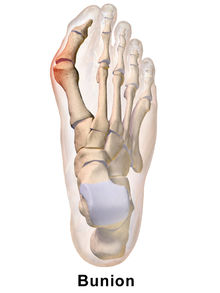Advancements in Minimally Invasive Bunion Surgery
April 5 2024
👣 Exciting News in Foot Care! 👣 Discover the latest advancements in minimally invasive bunion surgery! Say goodbye to lengthy recovery times and hello to quicker healing with smaller incisions and reduced discomfort. Learn more about this innovative approach to foot health. #BunionSurgery #MinimallyInvasive #FootCare 🦶💉
Patrick Bartholomew, DPM
Kevin Lam, DPM, FACFAS
OVERVIEW:
- What are bunions?
- Causes
- Prevention
- Treatment
Bunions, medically known as hallux valgus, are a common foot condition characterized by a bony bump at the base of the big toe. They can be painful and limit mobility, affecting the quality of life for many individuals. Traditional bunion surgery, known as bunionectomy, involves making a large incision and often requires a lengthy recovery period. However, advances in medical technology have led to the development of minimally invasive bunion surgery techniques, offering patients a more effective and less invasive treatment option.
Benefits of Minimally Invasive Bunion Surgery:
Minimally invasive bunion surgery offers several advantages over traditional bunionectomy. These include smaller incisions, reduced pain and discomfort, quicker recovery, and lower risk of complications. The smaller incisions result in less tissue damage and scarring, leading to a more comfortable recovery process.
Patients often experience less postoperative pain and discomfort due to the less traumatic nature of the surgery. Additionally, the quicker recovery time allows patients to return to regular activities sooner, improving their overall quality of life. The lower risk of complications, such as infection, is another significant benefit of minimally invasive techniques, making them a safer option for many patients.
The reduced pain and discomfort associated with minimally invasive bunion surgery are particularly noteworthy. Traditional bunionectomy can be quite painful, requiring strong pain medication and extended periods of rest. In contrast, patients who undergo minimally invasive surgery often report minimal discomfort and are able to resume normal activities much sooner. This is due in part to the smaller incision and reduced tissue damage associated with minimally invasive techniques.
Advances in Minimally Invasive Techniques:
Several advances have contributed to the success of minimally invasive bunion surgery. High-resolution imaging techniques, such as ultrasound and fluoroscopy, allow surgeons to visualize the bunion and surrounding structures with greater clarity. This helps them to perform the surgery more accurately and effectively. Surgeons also use specialized minimally invasive bunion surgery.
These instruments allow for precise and controlled movements, minimizing damage to surrounding tissues.
Moreover, surgeons have developed new techniques for correcting bunions using minimally invasive approaches. These techniques aim to realign the big toe joint while preserving as much healthy tissues as possible. As minimally invasive bunion surgery has gained popularity, more training programs and educational resources have become available for surgeons. This has led to improved surgical outcomes and patient satisfaction.
 Minimally invasive bunion surgery represents a significant advancement in the field of foot care. By offering patients a less invasive and more effective treatment option, it has revolutionized the way bunions are treated. As technology continues to evolve, further advances in minimally invasive techniques are likely to emerge, further improving outcomes for patients with bunions.
Minimally invasive bunion surgery represents a significant advancement in the field of foot care. By offering patients a less invasive and more effective treatment option, it has revolutionized the way bunions are treated. As technology continues to evolve, further advances in minimally invasive techniques are likely to emerge, further improving outcomes for patients with bunions.
Dr. Patrick Bartholomew is a podiatric physician and surgeon practicing in Southwest Florida. Board-Certified: American Board of Foot and Ankle Surgery.
If you are experiencing pain from a bunion, don’t delay. Contact Dr. Bartholomew’s office at (239) 430-3668 (FOOT) or visit www.NaplesPodiatrist.com to schedule an examination.



 Fax: (239) 692-9436
Fax: (239) 692-9436 Tel: 239-430-3668
Tel: 239-430-3668

